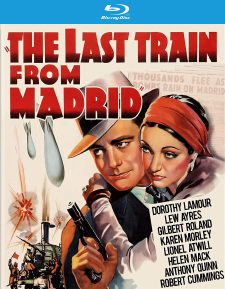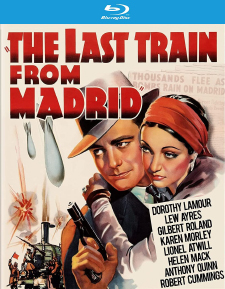Last Train from Madrid, The (Blu-ray Review)

Director
James P. HoganRelease Date(s)
1937 (September 20, 2022)Studio(s)
Paramount Pictures (Kino Lorber Studio Classics)- Film/Program Grade: C-
- Video Grade: A-
- Audio Grade: B
- Extras Grade: B
Review
The Last Train from Madrid takes place during the Spanish Civil War and was made before the outcome was known. Taking a cue from Grand Hotel, the film offers a roster of stars and several stories developing simultaneously. The basic plot of characters trapped in a time of war and desperate to leave would be used five years later, far more successfully, in Casablanca.
In war-torn Madrid, the Loyalists are in control under the command of Col. Vigo (Lionel Atwill). The colonel puts Capt. Ricardo Alvarez (Anthony Quinn) in charge of granting passes to board the last train out of the city before the tracks are destroyed. Among the multitudes desperate for a pass are political fugitive Michael Balk (Lee Bowman); his daughter (Olympia Bradna); Lola (Helen Mack), who lives off of sugar daddies; a baroness (Karen Morley); a soldier assigned to a firing squad who refused to shoot helpless prisoners (Robert Cummings); American newspaper reporter Bill Dexter (Lew Ayres), and Eduardo de Soto (Gilbert Roland), who once swore an oath of comradeship with Capt. Alvarez but has taken the opposite side of the conflict. Further complicating their relationship is Carmelita Castillo (Dorothy Lamour), the woman they both love. If you look carefully, you will also see Alan Ladd as a soldier (in an uncredited appearance).
Gilbert Roland gives a respectable performance as de Soto and Ayres’ fast-talking reporter provides some lighter moments. Atwill doesn’t really convince that he’s a Spanish officer, but he does convey authority infused with some heart. Lamour doesn’t have much to do except look alluring and mysterious. It’s interesting to see a very young Anthony Quinn and Robert Cummings at the beginning of their film careers. Both would go on to make better pictures. Actors speak with a variety of accents with little consistency. Many of the actors make no effort at all to use a Spanish accent. Lamour, with a vacant look and somber expression, turns in such an understated performance that she seems to disappear. Though top billed, she has surprisingly little screen time.
What should be an interesting predicament is thwarted by a dreary screenplay, and the cast, overall, doesn’t have the star power to bring it to life. Despite the wartime setting, the film is nearly devoid of action. A few bits of newsreel footage are inserted to lend a sense of realism, but the film plays like stock melodrama. Under the direction of James Hogan, it plods along, not even given a splash of music here and there to add energy. Shot on studio sets and outdoor California locations, The Last Train from Madrid fails to suggest Spain in internal chaos. It’s ambitious in its attempt to portray individuals in peril, yet dilutes each story with too much going on.
The Last Train from Madrid was shot by director of photography Harry Fischbeck on 35 mm black-and-white film with spherical lenses, finished photochemically, and presented in the aspect ratio of 1.37:1. From a new 2K master, the Blu-ray from Kino Lorber Studio Classics is free of visual imperfections. Though somewhat soft in certain details, the overall picture quality is pleasing for a film that’s 85 years old. Contrast and film-like grain are pleasing, with some atmospheric shadows. The newsreel footage is markedly different in quality from the studio-filmed scenes. In one brief bit of newsreel footage, there are heavy black scratches on the left side of the frame. Good detail is apparent in uniforms, wax dripping down a candle, a close-up of a handwritten letter, train wheels, and steam from the locomotive’s engine. Lamour’s make-up and pulled back, parted down the middle hairstyle give her the look of an upper-class Spanish woman.
The soundtrack is English 2.0 mono DTS-HD Master Audio. English SDH subtitles are an available option. Dialogue is clear throughout. Only Roland, who was Mexican, uses a Spanish accent. Ominous explosions are heard frequently, suggesting the proximity of danger, but we never see them. Rousing music is heard under the opening credits, promising an exciting film, but is virtually nonexistent until the final fade-out. This definitely hurts the film, making dull scenes even duller.
Bonus materials include the following:
- Audio Commentary by Bryan Reesman
- Trailer (1:37)
- Road to Singapore Trailer (2:38)
- Donovan’s Brain Trailer (2:02)
- Thunder Bay Trailer (2:15)
- The Ride Back Trailer (2:21)
- The Song of Songs Trailer (2:42)
- The Accused Trailer (2:27)
In his commentary, entertainment journalist and author Bryan Reesman devotes considerable attention to the political and historical background of the Spanish Civil War. He notes that The Last Train from Madrid was the first Hollywood film to feature the conflict. A disclaimer at the beginning of the film says that the filmmakers have no bias, partly for economic reasons, partly because the outcome was unknown. Though it tries to be neutral, the film has a “pro-Franco aroma.” Because of the Hays Code, violence was tamped down. The ethnic backgrounds of the actors are mentioned in terms of their believability to portray Spanish characters. Both Roland and Quinn have roles atypical from those they had been playing on screen. Overviews are provided for key cast members. Dorothy Lamour made several records and had a nightclub act when her movie career waned. She’s best known for the Road pictures she made with Bob Hope and Bing Crosby. Robert Cummings’ varied career included two films for Alfred Hitchcock, a role as a professor studying the habits of teenagers in the first Beach Party movie, and starring roles in three different TV sitcoms. Lew Ayres was a conscientious observer during World War II but served as a medic. Of the 42,000 men registered as conscientious objectors, 6,000 were jailed and 25,000 enlisted in non-combat roles. The Catholic Legion of Decency had great influence at the time and urged Catholics to support the Nationalists against the Republicans, whom they deemed “godless communists.” Blockade, another film set during the Spanish Civil War, is compared with The Last Train from Madrid, whose advertising poster suggested far more action than the film contains and inaccurately depicted images of Ayres and Lamour embracing. In his concluding remarks, Reesman compares the film’s story to the war in Ukraine.
At only 77 minutes, The Last Train from Madrid seems much longer due to the sluggish pacing, uninspired direction, and soap-opera plot. It has the look of a film in which the studio tried its hardest to stuff in as many name actors as possible in the hope that they would shore up a shaky script.
- Dennis Seuling

